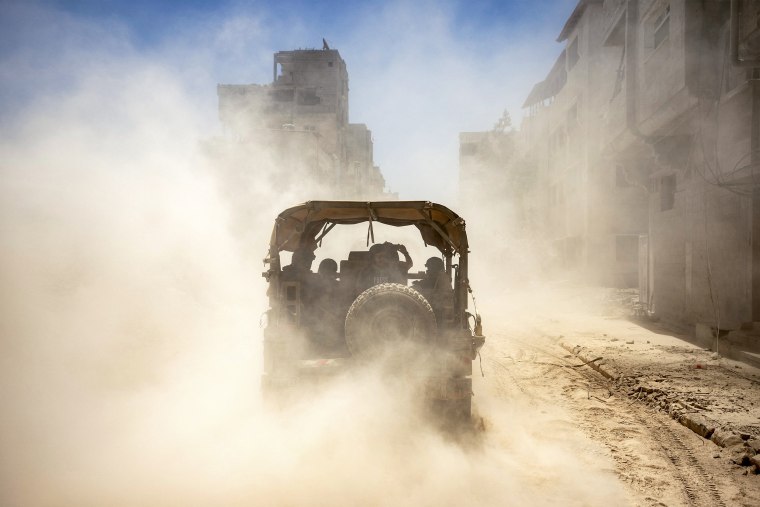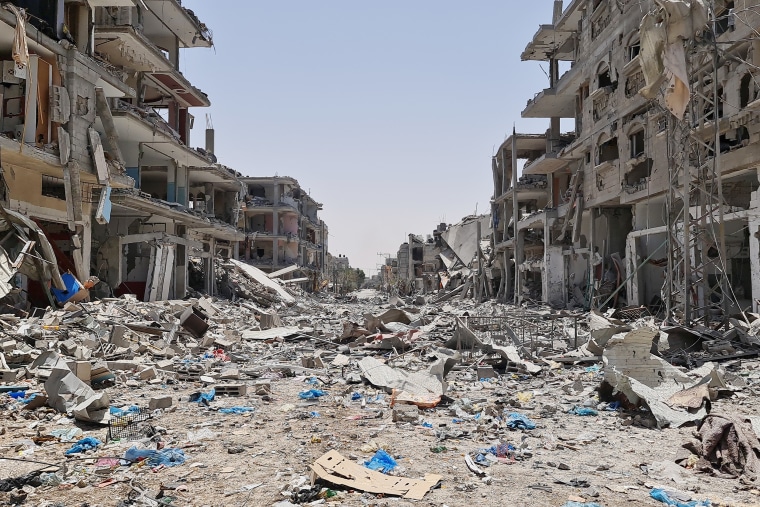RAFAH, Gaza — Homes destroyed, buildings reduced to rubble and few signs of life other than sporadic gunfire. That's all there is to see now in some parts of Rafah, the city in southern Gaza that was once home to more than 1 million people.
NBC News was given rare access to Rafah last week as Israeli forces operated in the city while efforts ramped up to negotiate a cease-fire deal that would bring fighting to an end in the enclave and see the release of the hostages.
Israel does not allow foreign journalists to enter Gaza independently, so troops from the Israel Defense Forces guided NBC News and other American outlets into the enclave. NBC News agreed to share raw video with the IDF and blur the faces of any junior soldiers. It did not allow the IDF to view any of this written report.
After entering Gaza through the Kerem Shalom border crossing at the corner of Gaza, Israel and Egypt, a military convoy traveled along the Philadelphi Corridor — the name for the southern border between Gaza and Egypt’s Sinai Peninsula. The roadway hugged the high-fenced border.
Egyptian guard towers and flags could seen on the other side.
Rafah is now an empty husk with almost every other building completely leveled. Those that remained upright are pocked with small-arms fire and holes from artillery fire.
Sporadic gunfire shows that fighting is ongoing.
Sand blown from the desert and beach formed dunes that lent the place a sense of permanent abandonment.
At one point, a man and a child peered out from behind a window curtain from the third floor of a wrecked building. They quickly ducked out of view.

Until just a few months ago, Rafah, which had a prewar population of around 250,000, saw its number swell to more than 1 million as many sought shelter after being displaced.
Many made temporary homes out of tents and in abandoned buildings, some ran market stalls while others volunteered to help the sick and injured or to provide programming for children grappling with trauma.
That all changed in May, when Israeli forces launched operations in the city, told people to evacuate and move north to Muwasi in central Gaza, which the IDF designated a “safer” zone.
Now, much of Rafah lies in ruins and Israeli soldiers said they were currently focused on trying to block tunnels they say run below the city's border with Egypt that are being used to smuggle contraband and weapons.
IDF spokesperson Rear Adm. Daniel Hagari told reporters that some of the tunnels had been booby-trapped. He said that large parts of the city had “tunnels underneath.” He added that some of the shafts “were in the houses.”
The IDF was “examining the tunnels ... in order to make sure we demolish it in the right way,” he added.

The Israeli military has said its forces have entered the third phase of its operations in Gaza, although it has not set out exactly what that entails.
On Monday, the military said its forces had also launched fresh operations in the north, targeting Hamas and Islamic Jihad operatives in the area of Gaza City. It added that troops were acting on intelligence that indicated the presence of “terrorist infrastructure, operatives, weapons and investigation and detention rooms, including in the UNRWA headquarters.”
NBC News was not immediately able to independently verify the IDF's claims and a spokesperson for UNRWA, the United Nations agency for refugees, said they did not have any information on the attacks. UNRWA has repeatedly denied allegations that its facilities are being used by Hamas.
An NBC News crew on the ground in Gaza City said sounds of gunfire, airstrikes and artillery fire could be heard ringing out across the city.
The apparent resurgence of Hamas and Islamic Jihad's presence in the north reflects a trend of militants reappearing in areas the IDF said it had previously cleared.

The U.S. has in the past warned that Israel would not be able to eliminate Hamas' presence in Gaza entirely, although Prime Minister Benjamin Netanyahu had previously stated this as one of the goals of the war, along with securing the release of all the hostages.
Elsewhere, CIA Director William Burns is expected to travel to the Qatari capital of Doha this week to take part in talks aimed at ending the conflict, a senior administration official familiar with the plan told NBC News.
Health officials in the enclave say more than 38,000 people have been killed in Gaza since Hamas’ Oct. 7 attacks, which Israel said saw some 1,200 people killed and around 250 others taken hostage.
Matt Bradley reported from Rafah and Chantal Da Silva from London.

